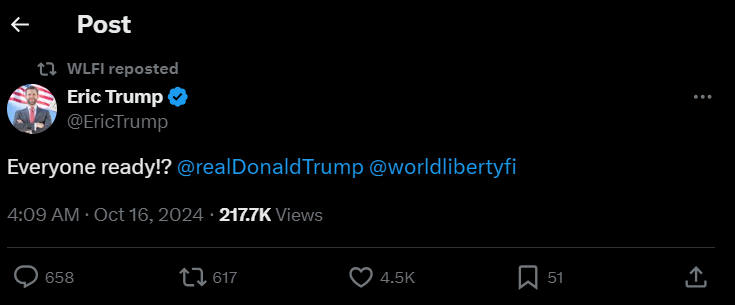
Liberty Finance launched its presale of the WLFI token, aiming to raise $300 million. However, the presale brought in only $12 million, just 4% of the intended goal.
Even with the initial hype with the Trump’s straight announcement on Twitter about the sale live and stated “Crypto is the Future”. Even with this support, the presale numbers did not meet expectations, the first 30 hours of sales showed disappointing results, with only a fraction of the targeted funds achieved.
Liberty Finance set a goal of raising $300 million during its presale, which was supposed to support the initial valuation of $1.5 billion for the platform. The idea was to sell 20 billion WLFI tokens at 1.5 cents each, but only about 788 million tokens were sold, totaling just under $12 million. This represented less than 4% of the available tokens.
The Trump Connection to Liberty Finance
Donald Trump, acting as the “chief crypto advocate,” played a central role in promoting Liberty Finance. His sons Eric, Donald Jr., and Barron were also heavily involved, holding positions as Web3 ambassadors and DeFi visionary.

Platform Issues and Investor Concerns
Several factors may have contributed to the presale’s underperformance. One of the major issues was technical difficulties on the Liberty Finance website. Shortly after the presale launched, the website suffered from frequent outages, displaying “We are under maintenance” messages. This caused delays and frustration for potential buyers, possibly discouraging them from completing transactions.
WLFI as a Governance Token
Liberty Finance marketed WLFI as a governance token, allowing holders to vote on protocol decisions such as updates and security measures. However, this raised concerns among some investors, as the platform it was meant to govern did not yet exist. Without an operating crypto bank or DeFi services, there were no immediate benefits for token holders. For now, WLFI token holders are left with a sort of IOU, as the project remains in its early stages of development.
The Fundraising Challenge
Raising capital without registering the token as a security with the U.S. Securities and Exchange Commission (SEC) was another challange. While the Regulation D providing used by Liberty Finance allowed them to bypass some regulatory requirements, it came at the cost of limiting investor participation. This cautious approach may have reduced the number of interested buyers, especially given the restrictions on U.S. retail investors.
Thus the project had not yet released a comprehensive white paper or business plan to the public, relying mostly on a short proposal posted on Aave’s governance forum. This lack of detailed information may have made some potential investors hesitant to commit.
Traffic and Website Outages of Liberty Finance
On the day of the presale launch, the Liberty Finance website received an overwhelming amount of traffic. According to WLFI advisor Sandy Peng, the website experienced 72 million unique visits in its first hour, causing the site to crash multiple times. Although the team switched to a new hosting service and restored the site intermittently, the frequent outages undoubtedly affected sales. In the first few hours, about 344 million tokens were sold to roughly 3,000 unique wallets, but this amounted to only 1.7% of the total tokens available for sale.
Revenue Distribution of Liberty Finance
Even with the underwhelming presale performance, Donald Trump is still set to receive 75% of all revenue generated, including the proceeds from the presale. The first $30 million, however, is reserved for covering expenses. Given that only $12 million has been raised so far, it remains unclear how Trump and the team behind Liberty Finance will proceed if they continue to fall short of their fundraising goals.
The Road Ahead
Right now, Liberty Financial has only just started on its $300 million goal. The platform’s plan to introduce a crypto bank, allowing users to borrow, lend, and participate in DeFi activities, remains in progress. The team has begun the approval process with Aave, one of the more established DeFi platforms. However, without a working platform or clear project details, many investors might still be unsure.
Conclusion
Liberty Financial’s WLFI token presale started with high hopes but has struggled to meet its ambitious goals. Technical difficulties, a restricted investor pool, and the lack of a functioning platform have all contributed to the slow progress in raising funds. While Donald Trump’s support created some early interest, the project needs to fix its problems to gain more attention.








